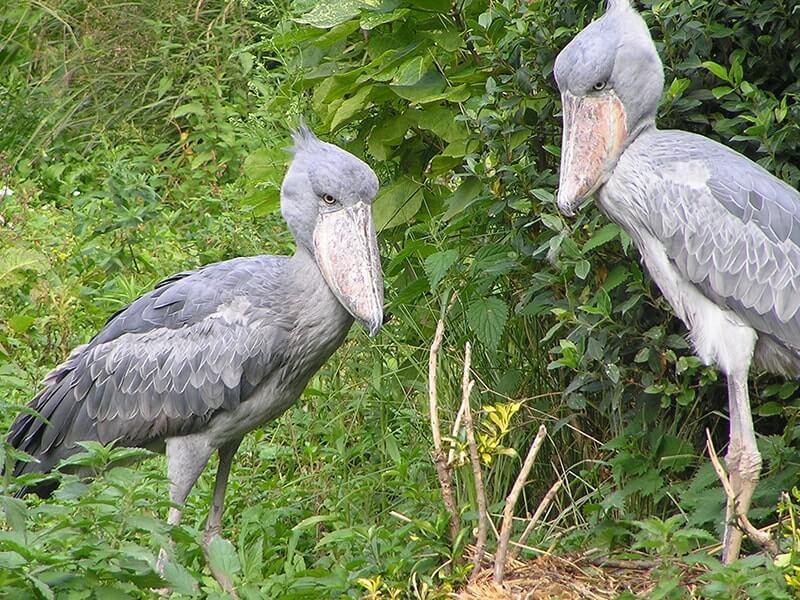Mabamba Swamp – A Wetland for Bird Watching on Lake Victoria Shorelines
Mabamba Swamp also known as Mabamba Bay Wetlands is a bird watching swamp popularly busy with tours of the Shoebill Stork as well as other bird species. Mabamba Wetland is just one of the many vital birding areas in Uganda. Found west of Entebbe Peninsula across Lake Victoria, the swamp is about 50 kilometers from Kampala City. Well toured on powered canoes through its water ridges, Mabamba Swamp is among the best birding watching spots in Uganda with Shoebill Bird Watching being the key activity. The swamp is also not far from Entebbe town and Entebbe International Airport, giving it an easy strategic access by visitors to Uganda. This also means that whoever wants to do a 1 day Entebbe tour can include Mabamba in the trip plan. On the other hand, a 1 day Mabamba Swamp Shoebill Bird Watching toursmay as well a tour of various tourist attractions in Entebbe including the Botanical Gardens and the Snake Park (Entebbe Reptile Village). Other tourist places in Entebbe Peninsula also include the Uganda Wildlife Education Center (UWEC) or Entebbe Zoo among others.

Occupying an area of 2424 hectares characterized by thick papyrus marshes, water ridges and unique wetland grasses, the swamp is among the Ramsar Sites in Uganda as well as an Important Bird Area (IBA). The wetlands is a habitat for around 300 bird species recorded, with seven of the twelve Lake Victoria Basin species found in Uganda available in the swamp. According to recent surveys, recorded bird species in Mabamba Swamp include the indefinable Shoebill stork, the Papyrus Gonolek, Mosque Swallow, the wandering House Sparrow, Weyn’s Weaver, White-shouldered Tit, Sand Martin and the Brown Snake-Eagle.
Others are the Grosbeak Weaver, Eurasian Hobby, Blue-headed Coucal, Fork-tailed Drongo, Flappet Lark, Feral Pigeon, Striped Kingfisher, Long-Crested Eagle, Common Stonechat, Little bee-eater, Common Greenshank, Great Blue Turaco, Whinchat, Grassland Pipit, Grey Wagtail, Northern Brown-throated Weaver, Orange Weaver, Black-headed weaver, Tawny-flanked Prinia, Slender-billed Weaver, Yellow-backed Weaver and the Black Headed Gonolek among others.
More species on the list of Mabamba Bay, one of the tourist attraction in central region include Ruppell’s Long-tailed Sterling, Grecentraly-Headed Sparrow, Grey-headed Kingfisher, Spur-winged Lapwing, Yellow Wagtail, African Pied Wagtail, Olivaceous Warbler, Pied Kingfisher, Yellow Billed Stork, Tawny Eagle, Carruther’s Cisticola, Ross’s Turaco, Fan-tailed Widowbird, Yellow-throated Greenbul, Ashy Flycatcher, White-faced Whistling-duck, Rufous-naped Lark, Common Squacco Heron, Slender-billed Gull, Spur-winged Goose, Fulvous Whistling-duck, Long-toed Lapwing, Goliath Heron, White-browed Coucal, African Marsh Harrier and the Violet-backed Starling among the many.
The above mentioned bird species of Mabamba are all spotted on a canoes cruise across the vast wetlands that is watered by Lake Victoria. The birds are best seen morning hours when they trail their prey especially the mud-fish or frogs even though they can be spotted at any time throughout the day.
Accessing Mabamba Swamp
There are various routes visitors can use to reach this prominent destination.
- Entebbe to Mabamba – From Entebbe area, one can use a ferry that operates daily between Nakiwogo and Buwaya Landing sites. From Buwaya, you then proceed by road to the swamp which is between 15 to 20 kilometers.
- From Kampala or Entebbe, you can go through Nakiwogo – Buwaya landing sites to and from Mabamba to avoid a longer drive on of a marum road by Kasanje.
- Kampala to Mabamba – One can drive from Kampala along Entebbe road, turn off at Kisubi or Kitende areas on a marum road through Sisa, Nakawuka up to Kasanje and turn on left side up to Mabamba.
- You can also drive to Nakiwogo landing site in Entebbe, park your vehicles there and cruise by the boat direct into the swamp, search for a Shoebill plus other birds and return to the mainland.
- If you are coming from Western Uganda on a safari, you can turn off on your right along Masaka-Kampala highway at Mpigi and drive via Kasanje up to the swamp.
Comprehensive Guide: Mabamba Swamp Birding Tips, Rules, and Best Practices
Mabamba Swamp, located on the northwestern edge of Lake Victoria about 50 kilometers west of Entebbe, is one of Uganda’s most treasured birding destinations. This vast wetland is internationally recognized as an Important Bird Area (IBA) and a Ramsar Site due to its ecological importance and the diversity of bird species it supports. What draws most visitors here, however, is the chance to spot the Shoebill Stork—a prehistoric-looking and globally threatened bird that has become one of Uganda’s most sought-after wildlife sightings.
A Mabamba Swamp birding tour is typically done by canoe, led by local guides who know the channels and bird habitats intimately. The swamp’s papyrus reeds, lagoons, and open water patches host more than 300 bird species, including papyrus gonoleks, malachite kingfishers, swamp flycatchers, African jacanas, and blue-breasted bee-eaters. To fully appreciate this unique environment, visitors must combine curiosity with respect for nature. Below is a detailed explanation of the guiding tips, rules, and best practices to make your Mabamba birding experience safe, responsible, and unforgettable.
Guiding Tips for a Successful Mabamba Birding Experience
1. Start Early
Birding at Mabamba is most rewarding early in the morning—typically between 7:00 a.m. and 10:00 a.m.. During these hours, the air is cool, lighting conditions are ideal for photography, and bird activity is at its peak. Shoebills are often easier to locate then, as they hunt for lungfish in the shallow channels before temperatures rise. Early starts also help you avoid the midday heat and winds that can make canoe navigation more challenging.
2. Hire a Local Bird Guide
Hiring a local guide or ranger is essential, not just for navigation but also for enhancing the quality of your experience. Local guides have deep knowledge of bird behavior, breeding sites, and calls. They can recognize subtle movements or sounds that reveal a Shoebill’s location and will skillfully maneuver the canoe through narrow channels without disturbing wildlife. Additionally, engaging local guides supports community livelihoods and contributes directly to conservation efforts.
3. Bring the Right Gear
A well-prepared birder makes the most of every opportunity. Recommended equipment includes:
- Binoculars: 8×42 or 10×42 magnification for clear and stable viewing.
- Camera: A DSLR or mirrorless camera with a zoom lens (200mm or more) to capture birds from a respectful distance.
- Field Guide or Bird Checklist: Useful for identifying species and recording observations.
- Clothing and Accessories: Sunscreen, hat, and insect repellent are vital in the wetland’s open and humid environment.
Keeping your gear protected in waterproof bags or dry sacks is wise, as the canoes occasionally splash water when navigating.
4. Dress Comfortably and Appropriately
Comfort and camouflage go hand in hand during birding. Wear lightweight, breathable, and neutral-colored clothing—greens, browns, and greys—to blend into the natural surroundings. Avoid bright colors that may startle birds. Long sleeves and trousers offer protection from mosquitoes, sunburn, and papyrus reeds brushing against your skin. Sturdy shoes or sandals with good grip are recommended for boarding and disembarking the canoe safely.
5. Use Quiet Communication
Birds in wetlands are sensitive to noise. Maintain a quiet environment by speaking softly or using hand signals when spotting or identifying species. Avoid loud laughter, music, or unnecessary movement. Silence allows you to hear the distinct calls of species like the papyrus gonolek and white-winged warbler, adding depth to your experience.
6. Be Patient
Patience is one of the most valuable virtues in birding. Shoebills, in particular, are known for their motionless hunting posture and can stay still for extended periods. Your guide may spend 20–40 minutes scanning the swamp before spotting one. The wait is worth it—observing this majestic bird in its natural setting is an unforgettable reward. Take the time to also appreciate other birdlife, butterflies, and the peaceful wetland landscape while waiting.
7. Support Community Conservation
Mabamba’s birding tourism directly benefits local residents who manage the swamp and protect it from encroachment. Visitors are encouraged to support this community-based conservation model by:
- Hiring local guides and canoe operators.
- Purchasing handmade crafts or refreshments from community stalls.
- Donating to conservation programs that maintain the swamp’s ecological balance.
Your participation helps sustain both wildlife and the livelihoods of people who coexist with it.
Rules and Regulations During a Mabamba Birding Tour
To preserve Mabamba’s fragile wetland ecosystem and ensure everyone’s safety, all visitors should adhere to these essential rules and guidelines.
1. No Disturbing Wildlife
Respect for wildlife is non-negotiable. Never attempt to approach birds too closely or provoke them for a photograph. Avoid sudden movements, loud noises, or gestures that may disrupt nesting, feeding, or resting behavior. Remember that you are a guest in their habitat.
2. Stay Inside the Canoe
Canoe birding is safe and serene when balance is maintained. Always remain seated while on the canoe, and avoid leaning over the sides. Standing abruptly may tip or destabilize the vessel. Follow your canoe operator’s directions carefully, especially in shallow or narrow channels.
3. No Littering
The health of Mabamba Swamp depends on responsible visitor behavior. Do not leave behind plastic bottles, wrappers, or cigarette butts. Carry a small waste bag for your trash and dispose of it properly once back on shore. Even small items like bottle caps can harm wetland creatures.
4. No Feeding Birds
Feeding birds can alter their natural feeding patterns and cause dependency on human food, which is often unhealthy for them. Let birds forage naturally to maintain ecological balance.
5. Respect Private and Restricted Areas
Parts of Mabamba Swamp are managed by local communities and used for fishing or papyrus harvesting. Other zones are designated breeding grounds. Follow your guide’s instructions and do not enter restricted areas. Respecting these boundaries helps protect both wildlife and community interests.
6. Follow Safety Guidelines
Every visitor must wear a life jacket while on the canoe. Avoid standing, playing with water, or making sudden shifts in weight distribution. Keep hands and equipment inside the canoe to prevent accidents. Always check the weather forecast before the tour—avoid strong winds or heavy rain that may make canoeing risky.
7. Photography Etiquette
Photography is a big part of birding, but it must be done responsibly. Turn off your camera’s flash to avoid startling birds. Use a zoom lens to get close-up shots from a distance instead of approaching the birds. When photographing local guides or community members, ask for permission first—it’s a simple gesture of respect.
8. Permits and Fees
Entrance and guiding fees are payable at the Mabamba Community Office or Conservation Center before the tour. These funds are crucial for maintaining canoes, compensating guides, and supporting conservation and education programs. Always ensure your payments are made through the official channels.
Why Responsible Birding Matters
Mabamba Swamp is more than a birding hotspot—it’s a living ecosystem that sustains hundreds of species and provides vital ecological services like water filtration and carbon storage. By following these tips and rules, you help protect this delicate environment for future generations. Responsible birding ensures that wildlife continues to thrive while local communities benefit from sustainable tourism.
Key Takeaway
A Mabamba Swamp birding tour is not only about seeing the Shoebill Stork—it’s about immersing yourself in the wonder of Uganda’s wetlands while promoting conservation and community empowerment. When visitors act responsibly, listen to their guides, and minimize their impact, Mabamba remains the magical, bird-filled paradise it has always been.
A trip here rewards patience, respect, and curiosity with unforgettable encounters and the satisfaction of knowing you’ve contributed to preserving one of Africa’s most precious bird sanctuaries.
